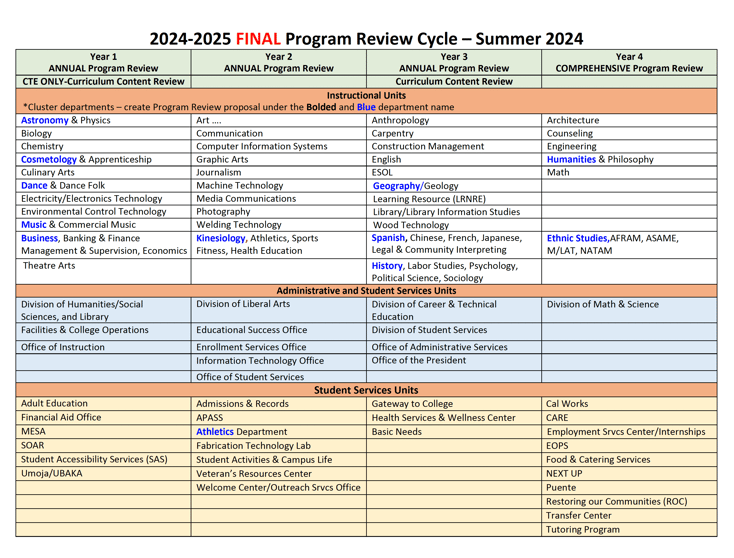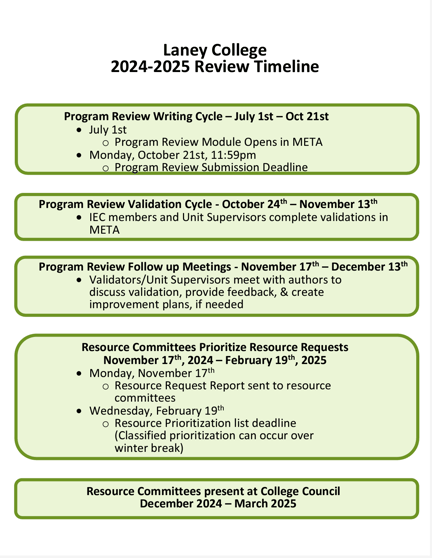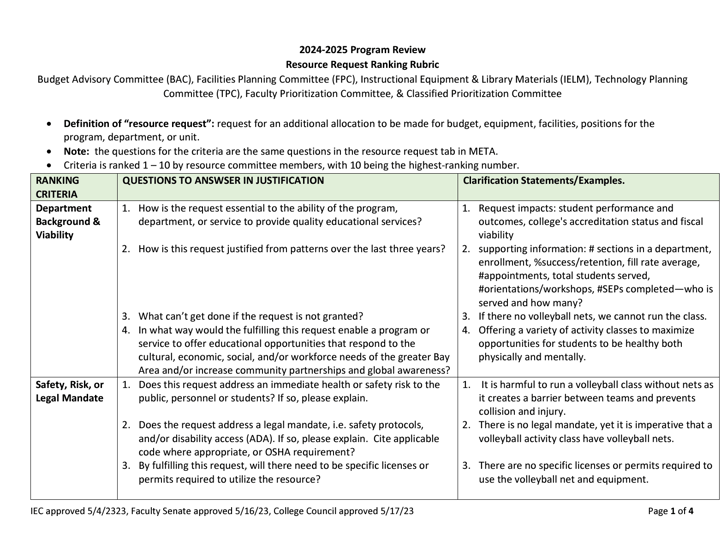Trainging Materials and Department Chair Assessment Training
Training Materials
Below is a visual representation of how each level of assessment in Meta connects to the others. For an enlarged image, right click on the document to open in a new tab.
Searching Meta
Find Your Own, Or Your Department/Cluster Assessments
Written Instructions
Instructions for Searching Meta
Video Instructions
less than 5 minutes
Find A Program (Degree/Certificate) And Outcome Mapping
Written Instructions with Screenshots
Super quick version of finding your Program Outcome Mapping
Video Instructions
Very helpful for developing assessment plans and prioritizing assessments (about 5 minutes)
Level 1
Written Instructions
Written step-by-step instructions on data entry, including screenshots: Meta Instructions Laney Assessment
Video Instructions
The 33 minute training video below provides step-by-step instructions on how to use the META Assessment Module to enter assessment data. While it’s mainly about data entry, there are some tidbits about how to do assessment. The training video has been transcribed and can be accessed here: Meta Assessment Training Level 1 Transcript
| Topic | Time |
| Intro and Login | 0:00 – 3:43 |
| Where your assessments live | 3:44 – 4:38 |
| Create proposal | 4:39 – 5:45 |
| Division, Dept, Title | 5:46 – 9:36 |
| Main (includes saving) | 9:37 – 15:10 |
| Assessment Methods/Tools (includes Success Criteria and uploading files/Attach Files tab) | 15:11 – 21:10 |
| Assessment Results (includes Delivery Method) | 21:11 – 25:25 |
| Reflection | 25:26 – 27:00 |
| Action Plan (includes choosing next assessment date and finishing up) | 27:01 – 32:52 |
Video Instructions for the ILO tab
coming soon!
Best Practices
Already know the basics of Level 1, and you’re ready to step up your assessment game? Ready to see the true value of assessment? This section is for you!
Written Instructions, for individual assessments
Simplified, one-page document: Assessment Best Practices Training Doc
Video Instructions, for individual assessments
For more details and examples, check out the video (about 15 minutes)
Levels 2 and above
Level 2
P/T faculty can earn an increased stipend for a Level 2 assessment! Details below
Written Instructions
Simplified, one-page document: Level 2 Training Doc
(watch the video for details on creating the Level 2 proposal in curriqunet Meta)
Video Instructions
The first 6 minutes cover what “levels” mean in Meta, how they relate to each other, and why you would need a Level 2 assessment. (about 15 minutes total)
If you are returning to this video for a quick review of how to create and fill out a Level 2 proposal, feel free to jump to 6: 19
Levels 5 and 6 – Program Assessment
Please note that you should complete the other training on this page to prepare for this section. In particular, locating your program and outcome mapping, and completing Level 2 assessments, are key.
Super quick version of finding your Program Outcome Mapping
Written Instructions
These are the PowerPoint slides that cover the basic principles of program assessment and how Meta connects foundational SLO assessment to program assessment:
Program Assessment, Levels 5 and 6
Video Instructions
(total 44 minutes)
The first 21 minutes cover the basic principles of program assessment and the big picture of how assessment works in Meta. From there, we get into curriqunet Meta and show how to create Levels 5 and 6, to finish off your program assessment.
CANVAS “CLASS”
Use the following link to “self enroll” in the Canvas class created to help with all things assessment.
Department Chairs Assessment Training
Purpose and Process
This training has two main purposes:
- To walk you through how to complete the assessment section of your Comprehensive Program Review (CPR)
- To encourage you to develop ways to sustainably maintain assessment in your department
How to use this training:
ALL the parts of the training are important, especially if your department lacks experience with completing assessment.
- Read the information on this page, and watch the videos
- As you work on your CPR, refer back to the written documents that accompany some of the videos
- After you have completed the training on this page, you will meet with the Assessment Coordinators, who will address your questions about the training, and advise you in regard to the specific needs of your department (these meetings typically will occur in September of the fall semester your CPR is due)
What are you going to get out of this training?
- Foundations – the background information you need to write the assessment section of your CPR, and to set up your department for a successful future with assessment
- Planning – how to create an assessment plan
- Addressing the CPR Questions – what are the assessment questions in the CPR, and how to best address them
Foundations
The CPR Rubric
22-23-CPR-Rubric-Instruction
Video (6 minutes)
Departmental Best Practices
Written Instructions
Best Practices in Assessment, Department Level
Assessment, Steps to Getting it Done
Video Instructions (10 minutes)
Existing Department Assessments
SLO Assessments
Written Instructions
Instructions for searching Meta
Video Instructions (less than 5 minutes)
Program Assessments
Check here to see if your department has published program assessments
Programs and Outcome Mapping
Video Instructions (about 5 minutes)
Stipends for P/T Faculty
Full-time faculty, as part of their regular jobs, are expected to complete assessment according to the Peralta Board Policy and accreditation standards. Part-time faculty may earn a stipend for their assessment work. Details below
P/T Faculty stipend details
How do P/T faculty earn the assessment stipend?
Due date for Fall 2024 assessment: January 31st, 2025
Please make sure to follow guidelines for data entry in training materials, or payment may be delayed.
- Enter assessment data in Meta – See training materials on this site below
- You’ll earn $100 per course, up to the maximum $300 – Assessing multiple SLOs in the same course in a given semester will be paid as one assessment, as is past practice.
- When you enter data, you’ll give your assessment a title – Please ensure your title matches the examples in the training materials. Email the assessment title(s) to Huizhen (Joan) Su with the subject “assessment stipend.” If multiple p/t faculty participate in the same assessment, a representative of the group may send ONE email with all the names.
- Joan will verify data entry – This will be done on an ongoing basis, but please meet the deadlines above.
- The Business Office may require your signature on a timesheet to pay the stipend – please look out for a message from Joan and respond.
Increased Stipend for Disaggregation of Data
When there are multiple sections of a course, it may be useful to separate the assessments by certain criteria, such as day vs. evening sections, online vs. face-to-face sections, etc. We call this disaggregation of data, and it may be very helpful to you, to your department, and to the college for accreditation purposes.
The assessment coordinators will work with you to pre-approve increasing your stipend on a case-by-case basis.
- Discuss your plan with the Assessment Coordinators ahead of doing the assessment – please message Rebecca Bailey and Felipe Wilson with your request to meet/discuss using the subject line “request for increased stipend.” The Assessment Coordinators will inform Joan if you are approved for an increased stipend.
- Enter data on Level 1 – you’ll enter at least two separate assessments at Level 1, which is simply the standard way most faculty enter assessment data (for example, one for a daytime section, and one for an evening section) paid at $100 each
- Enter data on Level 2 – After completing the Level 1 assessment, check out the Level 2 training video. Entering Level 2 data will be paid at $100. This part must be completed to earn the increased stipend. Let the assessment coordinators know when you’ve launched the Level 2, so they can approve it (Level 1 is approved automatically).
- When you enter data, you’ll give your assessment a title – Please ensure your title matches the examples in the training materials. Email the assessment title(s) to Huizhen (Joan) Su with the subject “increased assessment stipend.” If multiple p/t faculty participate in the same assessment, a representative of the group may send ONE email with all the names.
- Joan will verify data entry – This will be done on an ongoing basis, but please meet the deadlines above.
- The Business Office may require your signature on a timesheet to pay the stipend – please look out for a message from Joan and respond.
The maximum you can earn in a single semester is increased to $600 for this type of assessment
Planning
Find the Most Recent Template
Assessment Planning Document
Video Instructions (27 minutes)
Addressing the CPR Questions
Video Instructions (7 minutes)
Program Review Overview
Program Review is a planning process which creates a document that shows the current state of a unit, how a unit is connected to the college and community and explains how a unit wants to move forward in the next few years.
All program reviews are completed and stored in CurrIQunet META.
9/12/24: Program Review Help Session Sign up Sheet
10/19/23: Video on Adding Graphics to Program Review
10/11/23: Video on BI Tool Data Exporting
Program Review Information & Resources
Cycle
Program Review Cycle
Laney College is on a four-year program review cycle. A program is an umbrella term that includes: Instructional Departments, Administrative Units, Student Services Units, and Student Services Units with Instruction. A program completes a comprehensive program review (CPR) every four years and an annual program review (APR) each of the interim three years. Download the Program Review Cycle by clicking on the image to the left to find out what Program Review year your unit is in.

Timeline & Key Dates
Review Timeline
All program reviews are due by Monday, October 21st, 2024 at 11:59pm. Download the Program Review Timeline for an overview of key dates.

Rubrics
Resource & Validation Rubrics
Use the rubrics below to guide your program review responses. At the bottom of each rubric is a list of “minimum requirements”. These are the minimum requirements needed to pass the validation process and have resource requests forwarded to the resource prioritization committees.
Annual Program Review (APR) – All Programs/Areas/Units
Comprehensive Program Review (CPR) –
Instruction
Comprehensive Program Review (CPR) – Special Programs/Service Areas
Comprehensive Program Review (CPR) – Administrative Units

Training
Curriculum & Assessment Training
META Training
Video on Adding Graphics to Program Review
Video on BI Tool Data Gathering and Exporting
Reserve a spot on Google Doc Sign Up Sheet for Training & Help with Program Review Coordinator & Trainer
Heather Sisneros - hsisneros@peralta.edu

2019-2020 Program Reviews
Pt.1: Comprehensive Program Reviews
Download PDF.
Pt. 2: Annual Program Reviews (A-I)
Download PDF.
Pt. 3: Annual Program Reviews (J-W)
Download PDF.
2018-2019 Program Reviews | Pt.1: Comprehensive Program Reviews
Admissions and Records Comprehensive Program Review
Assessment Office Comprehensive Program Review
Computer Information Systems Comprehensive Program Review
Enrollment Services Comprehensive Program Review
Graphic Arts Comprehensive Program Review
Information Technology Office Comprehensive Program Review
Journalism Comprehensive Program Review
Kinesiology, Athletics, Sports Fitness, and Health Education (KASH) Comprehensive Program Review
Liberal Arts Division Office Comprehensive Program Review
Machine Technology Comprehensive Program Review
Media Comprehensive Program Review
Photography Comprehensive Program Review
Student Life Department Office Comprehensive Program Review
Veteran’s Affairs Comprehensive Program Review
Vice President of Student Services Division Office Comprehensive Program Review
Welcome Center Comprehensive Program Review
Welding Comprehensive Program Review
2018-2019 Program Reviews | Pt.2: Annual Program Reviews
Biology Annual Program Review
Business and Administrative Services Annual Program Review
Business and Economics Annual Program Review
Communications Annual Program Review
Cosmetology Annual Program Review
Counseling Office Annual Program Review
Culinary Annual Program Review
Carpentry Annual Program Review
Chemistry Annual Program Review
Chinese Annual Program Review
Dance Annual Program Review
Disabled Students Programs and Services (DSPS) Annual Program Review
Distance Education Annual Program Review
Engineering Annual Program Review
English Annual Program Review
English Speakers of Other Languages (ESOL) Annual Program Review
Ethnic Studies Annual Program Review
Facilities Office Annual Program Review
Food Services Annual Program Review
Geography Annual Program Review
Humanities and Philosophy Annual Program Review
Japanese Annual Program Review
Library Annual Program Review
Math Annual Program Update
Math and Sciences Division Office Annual Program Review
Music Annual Program Review
Office of Instruction Annual Program Review
Physics and Astronomy Annual Program Review
President’s Office Annual Program Review
Social Sciences Annual Program Review
Spanish Annual Program Review
Student Services Annual Program Review
Theatre Arts Annual Program Review
Transfer Center Annual Program Review
